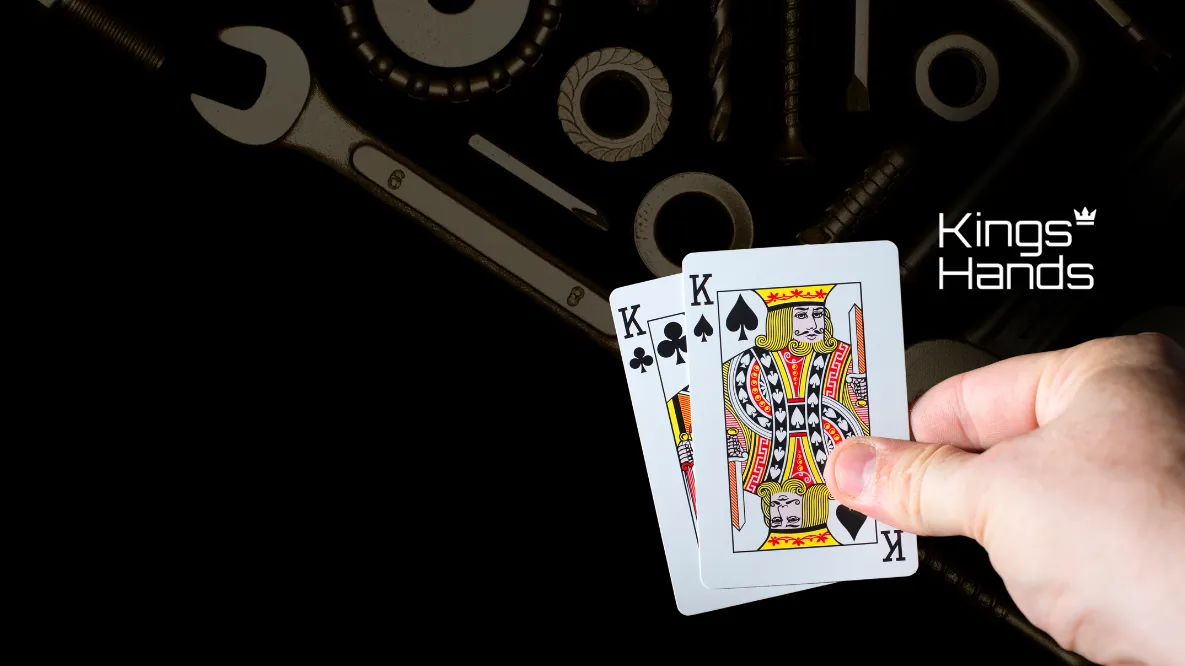When faced with a river bet, many people will consider the pros and cons of calling, but won’t even consider raising. Finding the guts to make a big raise on the river can be daunting, but with the help of EV calculations, you can feel secure in the knowledge that your raise is the most profitable move – no matter what the result is.
In this article, we’ll be looking at how to calculate whether calling or raising the river is the better option, why it’s useful to know this, and how to implement it in your game.
Why Is It Useful To Know The Difference In EV Between Raising And Calling?
When we calculate the difference in EV between raising the river and calling the river, we can find the most profitable decision in any given river scenario. When we find ourselves facing a river bet with a marginal hand, it can be easy to fall into the mindset of only considering call or fold. However, by opening our minds to an aggressive river action, we provide ourselves with two ways to win the pot and can find a profitable situation where one otherwise may not exist.
How Do We Calculate The Difference In EV Between Calling And Raising?
To compare the difference between the EV of calling and the EV of raising, we need to perform two EV calculations; one to calculate the EV of calling, and another to calculate the EV of raising. Once you have the results of the two calculations, you compare the two results to see which offers a higher expected value. Let’s take a look at an example to demonstrate.
You’re on the river in a $1/$2 cash game with 9d8d on a board of Ad9s5c3hJd. Your opponent bets $50 into a $100 pot and you’re deciding whether calling or raising to $200 has the highest EV. You think that if you call, you’ll win around 20% of the time, and if you raise, your opponent will fold 70% of the time.
To do this, you start by calculating the EV of calling, which you can do with the equation below.
Call EV = (Call Equity * Pot Size) – (Amount to Call * (1 – Call Equity))
Let’s plug our numbers into this equation and see what the result is.
Call EV = (0.20 * $150) – ($50 – (1 – 0.20))
Call EV = $30 – ($50 * 0.80)
Call EV = $30 – $40 = -$10
As you can see, the EV of our call is -$10, which means that a call would not be profitable in this situation. For most players, this is where the thinking would stop, and they would throw away their hand. However, we’re going to think on the next level and calculate the EV of raising.
This one is a little more complicated, so let’s break it down.
Raise EV = (Fold % * Pot Size) + ((Call % * Win % * (Raise Size + Pot Size – Amount To Call)) – (Call % * Lose % * Raise Size)
Fold % – The percentage of the time our opponent folds.
Pot Size – The size of the pot including our opponent’s bet
Call % – The percentage of the time our opponent calls
Win % – The percentage of the time we win the hand when called
Raise Size – The size of our raise
Amount to Call – The amount our opponent bet on the river
Lose % – The percentage of the time we lose the hand when called
That’s a lot to consider! However, in situations such as this one where we think we never win if we’re called, we can simplify the equation considerably.
Raise EV = (Fold % * Pot Size) – (Call % * Raise Size)
Doesn’t that look much better? What we’ve done is remove the chance of winning the pot, so we just calculate how much we win when our opponent folds, and how much we lose when our opponent calls. Those of you who read our Outright Bluffing EV page will probably recognise this equation!
So, with the simplified equation, let’s see what our EV looks like.
Raise EV = (0.7 * $150) – (0.3 * $200)
Raise EV = $105 – $60 = $45
As you can see, the EV of raising the river is highly profitable, particularly when compared to the negative EV of calling the river. By considering an aggressive option, we’ve presented ourselves with a positive EV scenario that we otherwise wouldn’t have found.
But what if we have a hand that’s got a chance of winning on the river? In these situations, we need to factor the EV of winning the hand into our equation to ensure we’re making an accurate assessment of our two options.
In this scenario, you’re on the river with top two pair facing a $100 bet into a $100 pot. You’re trying to decide whether calling the river or raising it to $350 has the highest EV. You think you’ll win 80% of the time when you call, your opponent will fold 75% of the time against your raise, and you’ll win 40% of the time when your raise is called.
Let’s plug these numbers into our more complex equation.
Raise EV = (0.75 * $200) + (0.25 * 0.4 * ($350 + $200 – $100)) – (0.25 * 0.6 * $350)
Raise EV = $150 + (0.25 * 0.4 * $450) – $52.50
Raise EV = $150 + $45 – $52.50
Raise EV = $142.50
Now we compare this to the EV of calling.
Call EV = (0.8 * $200) – ($100 * (1 – 0.8)
Call EV = $160 – ($100 * 0.2)
Call EV = $160 – $20 = $140
As you can see, the EV difference between these two actions is close, but it’s slightly more profitable to raise. While it may not seem like a small difference, these small differences add up in the long run, and if you’re not taking these small edges you’re leaving money on the table.
Raising Vs. Calling The River In Action
To see this concept in action, let’s take a look at a heads-up hand between Phil Hellmuth and Scott Seiver in High Stakes Duel Round 4. The action starts with Seiver limping the button for an extra 4K with 9d8d. Hellmuth raises to 29K from the BB with AhKs, Seiver calls, and the two see a flop of Qc5d2c.
Hellmuth checks, Seiver bets 18K, and Hellmuth makes the call. The turn brings the 4s, and the action checks through. The 8h hits the river, giving Seiver second pair. Hellmuth checks again, Seiver bets 30K, and the action’s back on Hellmuth.
Hellmuth is considering hero calling with his ace king, but he’s also considering what the EV would be of raising as a bluff. While it’s hard to know exactly what Hellmuth is thinking, for the purposes of this example, we can estimate that he likely thinks he’s good 40% of the time when he calls, will get Seiver to fold 70% of the time when he raises and that he’s never good if Seiver calls his raise.
Given those numbers, let’s look at how the EVs of these two actions compare.
Let’s start with looking at the EV of calling.
Call EV = (0.4 * 124,000) – (30,000 * (1 – 0.4)
Call EV = 49,600 – (30,000 * 0.6)
Call EV = 49,600 – 18,000 = 31,600
So, we can see the EV of calling is 31,600 chips. Let’s see how that compares to the EV of raising. Given that we think that Phil thinks his AK wouldn’t be good when called, we can use the simplified equation.
Raise EV = (0.7 * 124,000) – (0.3 * 110,000)
Raise EV = 86,800 – 33,000 = 53,800
As we can see, the EV of raising is more than 20,000 chips greater than the EV of calling. After working out the EV of the two actions and seeing that the EV of raising is significantly higher, Phil put in the raise, putting Seiver in a tough spot. While he deliberated for a couple of minutes, he eventually folded, giving Phil a significant pot.
Raise Vs. Call EV Quiz
Now that we know to consider the EV of both raising and calling when facing a river bet, let’s put your new knowledge to the test with a short quiz. You can find the answers at the bottom of the page.
Question 1
You’re on the river facing a $100 bet from your opponent into a $100 pot. What is the EV of raising the river to $400 with an expected fold percentage of 65% and an expected win % of 40%?
Question 2
You’re on the river facing a $40 bet from your opponent into a $100 pot and you’re considering calling or raising to $150. You expect to win 35% of the time when you call, you expect your opponent to fold 50% of the time when you raise, and you expect to win 0% of the time when called. Which action has the highest EV?
Question 3
You’re on the river facing a $55 bet into a $80 pot and you’re considering calling or raising to $300. You expect to win 80% of the time when you call, you expect your opponent to fold 70% of the time when you raise, and you expect to win 30% of the time when called. Which action has the highest EV?
Summary
Part of becoming a profitable poker player is being able to accurately assess the value of each available action. By limiting your options to call or fold when facing a river bet, you’re missing out on large amounts of value that can be found by taking an aggressive action. Using the tools we’ve given you, you’re now equipped to fully evaluate all options in your poker game!
Answers:
Question 1 – The EV of raising the river is $116.
Question 2 – The EV of calling is higher; the EV of raising is -$5 and the EV of calling is $23.
Question 3 – The EV of calling is higher; the EV of raising is $65.70 and the EV of calling is $97.





















